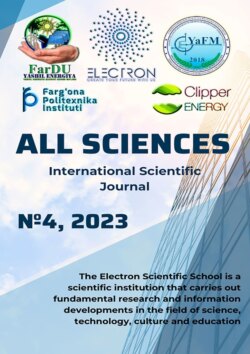Читать книгу All sciences. №4, 2023. International Scientific Journal - Ibratjon Xatamovich Aliyev - Страница 3
PHYSICAL AND MATHEMATICAL SCIENCES
OPTICAL AND SOUND MEMORY IN LITHIUM NIOBATE CRYSTALS
Ferghana State University, Ferghana, Uzbekistan
ОглавлениеAnnotation. PHOTOEDC (or photovoltage) in semiconductors, regardless of its nature, cannot exceed the band gap width, i.e. several volts/cm.
Keywords: PHOTOEDC, photovoltaic current, crystals without a center of symmetry, semiconductors, third-rank tensors, Fermi-level energies.
Аннотация. Фото-ЭДС (или фотонапряжение) в полупроводниках независимо от ее природы не может превышать ширину запрещенной зоны, т.е. несколько Вольт/см.
Ключевые слова: фото-ЭДС, фотовольтаический ток, кристаллы без центра симметрии, полупроводники, тензоры третьего ранга, энергии уровня Ферми.
For example, in a homogeneous semiconductor, the Dember (diffusion) photo voltage for an arbitrarily high intensity of exciting light does not exceed the value [1].
(1)
where Eg is the band gap of the semiconductor, n1 and n0 are, respectively, nonequilibrium and equilibrium carrier concentrations, Nc is the density of states.
Another example is the resulting photovoltage during illumination of the p-n junction [2].
(2)
which also does not exceed Eg. Here nn and pp are, respectively, electron concentrations in the n—region and holes in the p—region. EFn and EFp are Fermi—level energies in the n— and p-regions.
The exception to this rule was only semiconductor textures in which the effect of abnormally high photo voltages (AFN effect) is observed, due to the addition of elementary photo-EMF of the Dember (1) or elementary photo-EMF (2), developing at individual p-n transitions of the texture [3].
In such textures from sprayed layers of CdTe, Ge, Si, GaAs, PbS, CdSe, etc., photo voltages can reach values of the order of several hundred Volts per centimeter of length in the direction of addition of elementary photo-EMF (1) or (2).
In recent years it has become clear that currents are possible in thermodynamic nonequilibrium conditions of a different nature, due to the absence of a center of symmetry environment. The most important of this class of effect is the anomalous photovoltaic effect (AF effect).
The AF effect is that with uniform illumination of a short-circuited ferroelectric, a stationary current flows through it, which in [4,5] was called photovoltaic. It has been shown that it is the photovoltaic current that leads to the anomalous photovoltaic effect (AF effect) in ferroelectrics.
The anomalous photovoltaic effect detected for ferroelectrics for the first time in [4,5] is a special case of the AF effect described for crystals without a center of symmetry by the third rank aijk tensor [5,6]:
(3)
According to (3), with uniform illumination by linearly polarized light of homogeneous crystals without a center of symmetry (ferroelectric, pyro, or piezoelectric crystal), a photovoltaic current Ji arises in it, the sign and magnitude of which depend on the orientation of the polarization vector of light with projections EJ, EK*.
The components of the aijk tensor are nonzero for 20 acentric symmetry groups. If the electrodes of the crystal are opened, the photovoltaic current Ji generates photovoltaic voltages
where σt and σf, respectively, are dark and photoconductivity, l is the distance between the electrodes. Generated photovoltage in crystals without a center of symmetry of the order (103—105). In/see In accordance with (3) and the symmetry of the point group of the crystal, expressions can be written for the photovoltaic current Ji. Comparison of the experimental angular dependence Ji (b) with (3) makes it possible to determine the photovoltaic tensor aij or the photovoltaic coefficient
(a* is the light absorption coefficient).
In [10], the photovoltaic coefficient in lithium niobate crystals of the order K = (2-3) * 10—9A * cm* (W) -1 was determined.
This paper reviews and discusses photovoltaic, optical (photorefractive) and sound memory in lithium niobate crystals.
Use in holographic recording in LiNbO3:Fe gives advantages. In this case, the recording is carried out by the photovoltaic effect (FE) corresponding to the photovoltaic current.
Lithium niobate is widely used in holography and storage devices due to its excellent ferroelectric and piezoelectric properties. Just as magnetic materials «remember» the magnetic field, ferroelectrics can «remember» the electric field under certain conditions.
